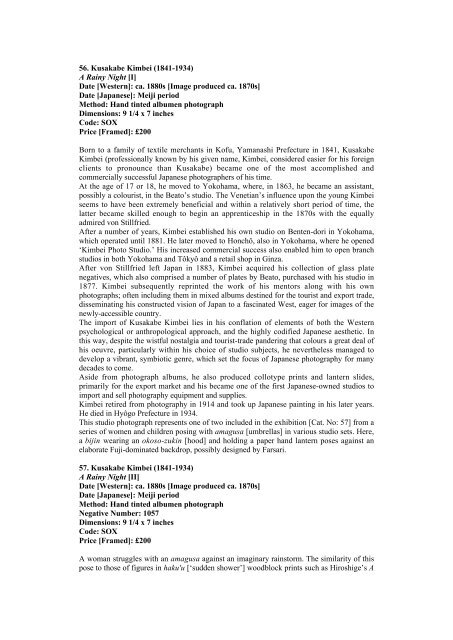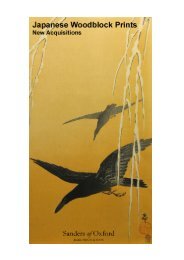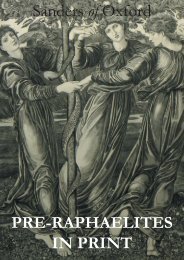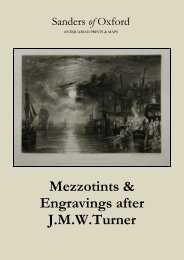Create successful ePaper yourself
Turn your PDF publications into a flip-book with our unique Google optimized e-Paper software.
56. Kusakabe Kimbei (1841-1934)<br />
A Rainy Night [I]<br />
Date [Western]: ca. 1880s [Image produced ca. 1870s]<br />
Date [Japanese]: Meiji period<br />
Method: Hand tinted albumen photograph<br />
Dimensions: 9 1/4 x 7 inches<br />
Code: SOX<br />
Price [Framed]: £200<br />
Born to a family <strong>of</strong> textile merchants in K<strong>of</strong>u, Yamanashi Prefecture in 1841, Kusakabe<br />
Kimbei (pr<strong>of</strong>essionally known by his given name, Kimbei, considered easier for his foreign<br />
clients to pronounce than Kusakabe) became one <strong>of</strong> the most accomplished and<br />
commercially successful Japanese photographers <strong>of</strong> his time.<br />
At the age <strong>of</strong> 17 or 18, he moved to Yokohama, where, in 1863, he became an assistant,<br />
possibly a colourist, in the Beato’s studio. The Venetian’s influence upon the young Kimbei<br />
seems to have been extremely beneficial and within a relatively short period <strong>of</strong> time, the<br />
latter became skilled enough to begin an apprenticeship in the 1870s with the equally<br />
admired von Stillfried.<br />
After a number <strong>of</strong> years, Kimbei established his own studio on Benten-dori in Yokohama,<br />
which operated until 1881. He later moved to Honchô, also in Yokohama, where he opened<br />
‘Kimbei Photo Studio.’ His increased commercial success also enabled him to open branch<br />
studios in both Yokohama and Tôkyô and a retail shop in Ginza.<br />
After von Stillfried left Japan in 1883, Kimbei acquired his collection <strong>of</strong> glass plate<br />
negatives, which also comprised a number <strong>of</strong> plates by Beato, purchased with his studio in<br />
1877. Kimbei subsequently reprinted the work <strong>of</strong> his mentors along with his own<br />
photographs; <strong>of</strong>ten including them in mixed albums destined for the tourist and export trade,<br />
disseminating his constructed vision <strong>of</strong> Japan to a fascinated West, eager for images <strong>of</strong> the<br />
newly-accessible country.<br />
The import <strong>of</strong> Kusakabe Kimbei lies in his conflation <strong>of</strong> elements <strong>of</strong> both the Western<br />
psychological or anthropological approach, and the highly codified Japanese aesthetic. In<br />
this way, despite the wistful nostalgia and tourist-trade pandering that colours a great deal <strong>of</strong><br />
his oeuvre, particularly within his choice <strong>of</strong> studio subjects, he nevertheless managed to<br />
develop a vibrant, symbiotic genre, which set the focus <strong>of</strong> Japanese photography for many<br />
decades to come.<br />
Aside from photograph albums, he also produced collotype prints and lantern slides,<br />
primarily for the export market and his became one <strong>of</strong> the first Japanese-owned studios to<br />
import and sell photography equipment and supplies.<br />
Kimbei retired from photography in 1914 and took up Japanese painting in his later years.<br />
He died in Hyôgo Prefecture in 1934.<br />
This studio photograph represents one <strong>of</strong> two included in the exhibition [Cat. No: 57] from a<br />
series <strong>of</strong> women and children posing with amagusa [umbrellas] in various studio sets. Here,<br />
a bijin wearing an okoso-zukin [hood] and holding a paper hand lantern poses against an<br />
elaborate Fuji-dominated backdrop, possibly designed by Farsari.<br />
57. Kusakabe Kimbei (1841-1934)<br />
A Rainy Night [II]<br />
Date [Western]: ca. 1880s [Image produced ca. 1870s]<br />
Date [Japanese]: Meiji period<br />
Method: Hand tinted albumen photograph<br />
Negative Number: 1057<br />
Dimensions: 9 1/4 x 7 inches<br />
Code: SOX<br />
Price [Framed]: £200<br />
A woman struggles with an amagusa against an imaginary rainstorm. The similarity <strong>of</strong> this<br />
pose to those <strong>of</strong> figures in haku'u [‘sudden shower’] woodblock prints such as Hiroshige’s A












